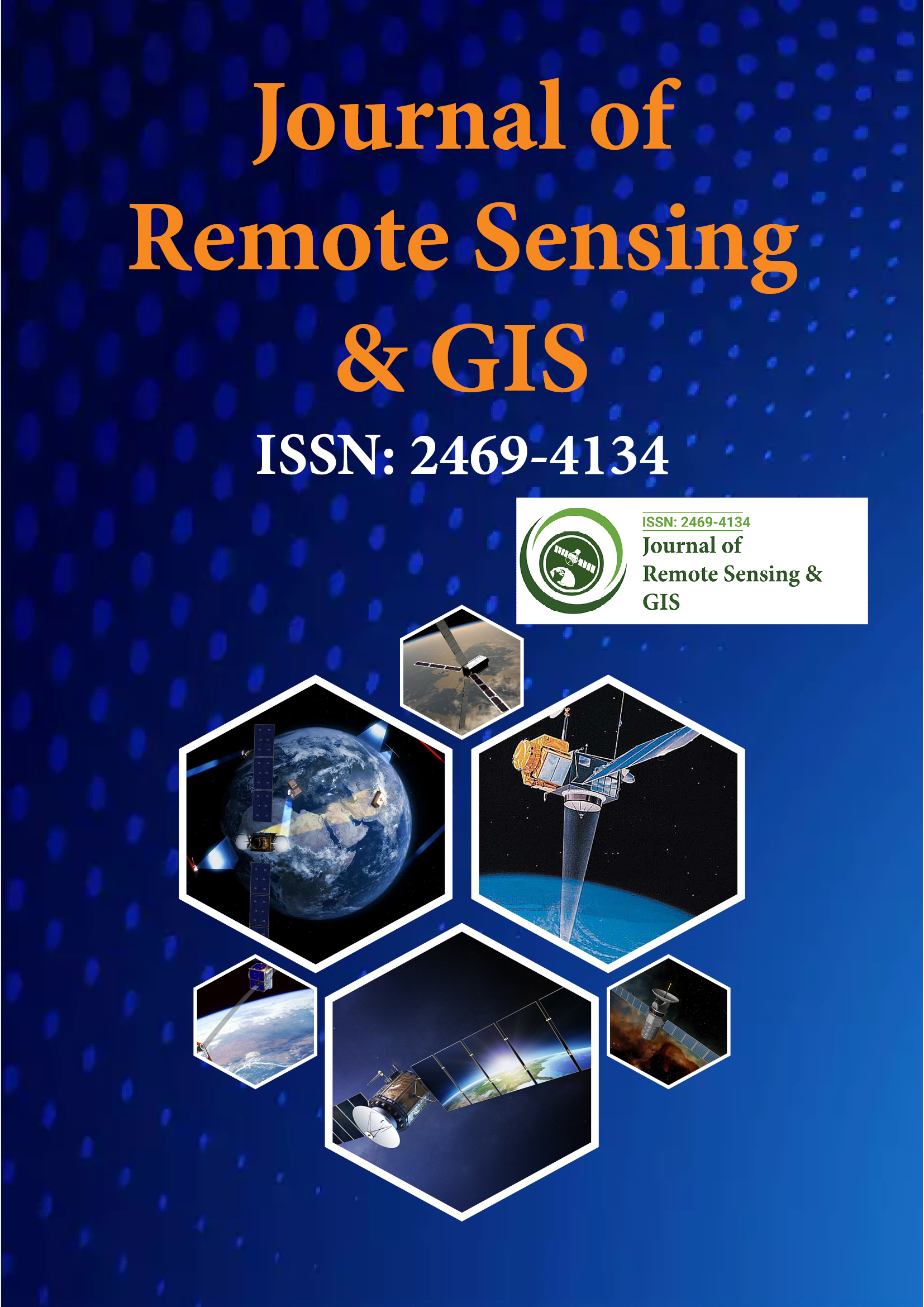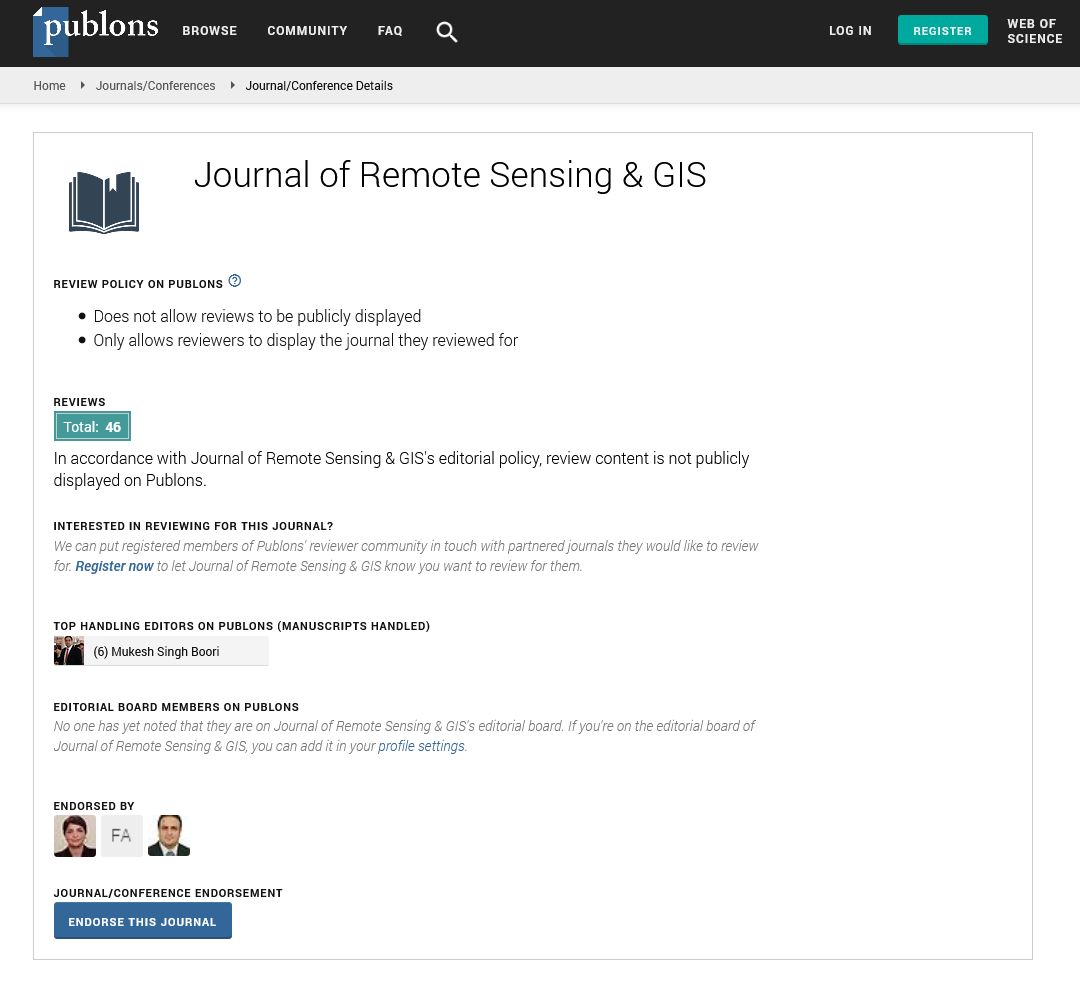Indexed In
- Open J Gate
- RefSeek
- Hamdard University
- EBSCO A-Z
- OCLC- WorldCat
- Publons
- International Scientific Indexing
- Euro Pub
- Google Scholar
Useful Links
Share This Page
Journal Flyer

Open Access Journals
- Agri and Aquaculture
- Biochemistry
- Bioinformatics & Systems Biology
- Business & Management
- Chemistry
- Clinical Sciences
- Engineering
- Food & Nutrition
- General Science
- Genetics & Molecular Biology
- Immunology & Microbiology
- Medical Sciences
- Neuroscience & Psychology
- Nursing & Health Care
- Pharmaceutical Sciences
Opinion Article - (2025) Volume 14, Issue 1
GIS Technology in the Modern World: Integrating Data, Space and Solutions for Real-World Challenges
Xiang Wan*Received: 25-Feb-2025, Manuscript No. JGRS-25-28690; Editor assigned: 27-Feb-2025, Pre QC No. JGRS-25-28690 (PQ); Reviewed: 14-Mar-2025, QC No. JGRS-25-28690; Revised: 21-Mar-2025, Manuscript No. JGRS-25-28690 (R); Published: 28-Mar-2025, DOI: 10.35248/2469-4134.25.14.376
Description
Geographic Information Systems (GIS) are frameworks designed for capturing, storing, analyzing and visualizing spatial or geographic data. They integrate hardware, software and data for managing information that is tied to a specific location. By combining layers of information, GIS enables users to understand spatial patterns and relationships across various disciplines, including environmental science, urban planning, agriculture, public health and disaster management.
Core components of GIS
A GIS system operates through the interaction of several fundamental elements:
Hardware: This includes computers, servers, GPS devices and mobile platforms used for data collection and processing.
Software: GIS software provides the tools for inputting, manipulating, querying, analyzing and displaying spatial data. Popular platforms include ArcGIS, QGIS and GRASS GIS.
Data: Spatial data, which describes the location and shape of geographic features, is the central component of any GIS. This includes raster data (e.g., satellite images, aerial photos) and vector data (e.g., points, lines, polygons).
People: Trained professionals and analysts who design and implement GIS projects, develop maps and interpret results.
Methods: The set of rules, procedures and models used to analyze and interpret data.
Spatial data types and sources
Spatial data in GIS falls into two primary categories:
Vector data: Represents discrete features such as roads, rivers, buildings and boundaries. It is stored as points, lines and polygons, each with attribute data describing characteristics (e.g., name, length, population).
Raster data: Represents continuous phenomena such as elevation, temperature, or land cover. It consists of grid cells or pixels, each holding a value that corresponds to the attribute being measured.
Data sources include satellite imagery, aerial surveys, GPS field data, remote sensing systems and existing databases. Increasingly, crowdsourced and open-source spatial datasets are also being incorporated into GIS platforms.
Key functionalities of GIS
GIS is not only a tool for visualization but also supports a range of spatial operations and analytical capabilities:
Data integration: GIS brings together data from different sources and formats, allowing for comprehensive spatial analysis.
Spatial analysis: This includes overlay analysis, buffering, proximity analysis, interpolation and surface modeling. These operations reveal spatial relationships that are not readily apparent from tabular data alone.
Geostatistics: Used for modeling spatial patterns and predicting values at unmeasured locations. Techniques include kriging, spatial autocorrelation and variogram modeling.
Map production: GIS enables the creation of accurate and thematic maps for a variety of uses, from land use planning to demographic analysis.
Temporal analysis: With time-stamped data, GIS can be used to track changes over time, such as deforestation, urban expansion, or disease spread.
Applications of GIS across disciplines
Major applications of GIS are:
Urban planning and infrastructure management: GIS supports land use analysis, transportation planning, zoning and infrastructure maintenance. It enables planners to visualize urban growth, analyze traffic flow and design efficient utility networks.
Environmental monitoring: GIS is widely used to study environmental changes such as land degradation, habitat loss, pollution and climate patterns. It supports conservation planning, ecosystem mapping and natural resource management.
Agriculture and precision farming: In agriculture, GIS helps optimize planting, irrigation and harvesting by integrating soil data, crop health imagery and climate data. It supports yield prediction and resource allocation.
Public health and epidemiology: GIS assists in mapping disease outbreaks, analyzing health disparities and planning healthcare services. It was instrumental in tracking COVID-19 spread and resource allocation.
Disaster management and risk assessment: GIS plays a key role in preparing for and responding to natural hazards such as floods, earthquakes and wildfires. It enables vulnerability mapping, evacuation planning and damage assessment.
Transportation and logistics: Logistics companies use GIS to optimize delivery routes, track fleets and manage inventories. Real-time tracking combined with spatial analysis improves efficiency and reduces costs.
Water resources and hydrology: GIS supports watershed analysis, flood modeling and groundwater mapping. It helps in monitoring water quality and planning irrigation systems.
Recent advancements in GIS technology
GIS continues to evolve with advances in computing and data collection:
Web-based GIS: Platforms like ArcGIS Online and Google Earth Engine allow users to access and analyze spatial data through web browsers, increasing accessibility.
Mobile GIS: Field data collection has been transformed through mobile devices with GPS and GIS applications, enabling realtime updates and decision-making in the field.
3D GIS and visualization: Modern GIS tools support 3D terrain modeling and city visualization, enhancing the understanding of complex landscapes and infrastructure networks.
Integration with remote sensing: High-resolution satellite data is increasingly integrated with GIS for real-time monitoring and analysis of environmental and urban systems.
Artificial intelligence and machine learning: These technologies are being incorporated into GIS to improve pattern recognition, automate classification and support predictive modeling.
Challenges and future directions
While GIS offers extensive capabilities, challenges include data accuracy, standardization, privacy concerns and technical complexity. Efforts are ongoing to improve data sharing, user training and interoperability between platforms. Looking forward, the combination of GIS with technologies such as cloud computing, blockchain and augmented reality may further enhance its role in decision-making and research.
Conclusion
GIS has transformed how spatial information is understood and applied across various sectors. Its ability to analyze and visualize geographic data supports informed planning, resource management and problem-solving. As technological advancements continue, GIS is expected to remain a key tool in addressing local and global challenges.
Citation: Wan X (2025) GIS Technology in the Modern World: Integrating Data, Space and Solutions for Real-World Challenges. J Remote Sens GIS.14:376.
Copyright: © 2025 Wan X. This is an open-access article distributed under the terms of the Creative Commons Attribution License, which permits unrestricted use, distribution and reproduction in any medium, provided the original author and source are credited.

